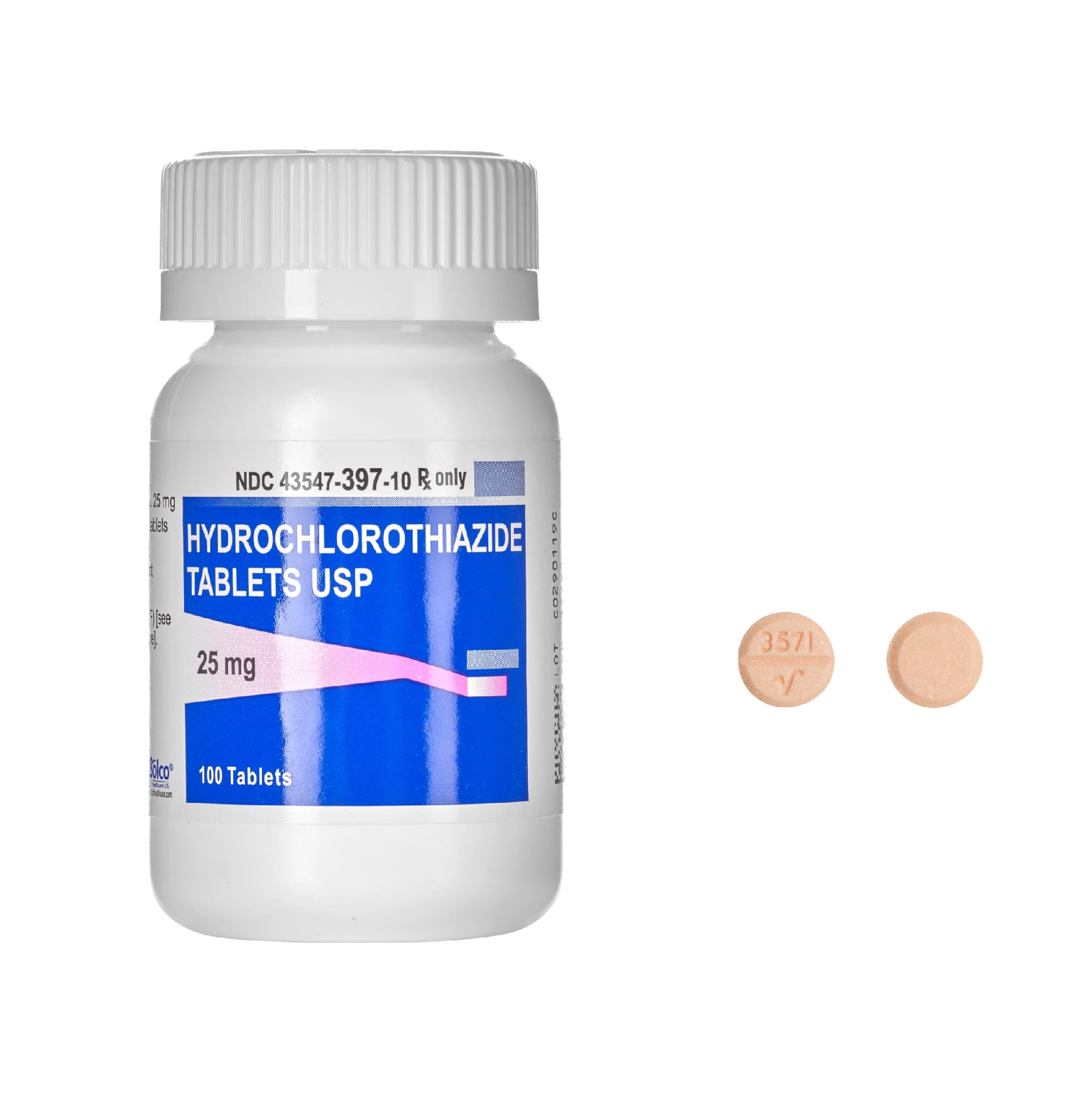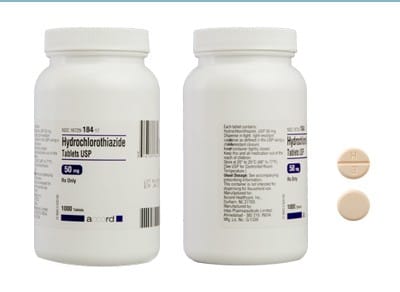Please note: a valid prescription is required for all prescription medication.
Hydrochlorothiazide Tablets for High Blood Pressure
Sitewide Super Sale - Get 15% off when you buy 3 or more of the same product using the code LESS15 at checkout.
Applies to all products originating from Canada. Maximum quantity limited to a 90-day supply per order.
Price range: $28.99 through $55.99
You save


Hydrochlorothiazide is a thiazide diuretic used for hypertension and fluid retention. This page explains safe use, key risks, and how to request supply.
What Hydrochlorothiazide Is and How It Works
Hydrochlorothiazide® helps the kidneys excrete extra salt and water through urine. That supports lower vascular volume and reduced swelling from heart, liver, or kidney conditions. You can access Canadian pricing with US shipping from Canada, which may help if you pay without insurance. CanadianInsulin.com is a prescription referral platform. We verify prescriptions with your prescriber when required, and licensed Canadian pharmacies dispense your order.
This medicine blocks sodium reabsorption in the distal tubule, which can lower blood pressure. Hydrochlorothiazide may be used alone or with other agents when additional control is needed. It is often called a water pill hydrochlorothiazide in everyday use. Treatment aims to improve long-term cardiovascular outcomes by controlling High Blood Pressure and limiting complications of volume overload such as Edema.
Who It’s For
This therapy is indicated for adults with essential hypertension and for edema tied to heart failure, liver disease, renal disorders, or steroid therapy. It can be used as initial therapy or combined with ACE inhibitors, ARBs, beta blockers, or calcium channel blockers when a multi-drug plan is appropriate. People with anuria or severe renal impairment should not use it.
Use caution if you have a history of gout, low sodium or potassium, or sensitivity to sulfonamide-derived medicines. Discuss use during pregnancy or breastfeeding with a clinician. Pediatric use for hypertension may be considered by specialists; follow the approved label and your prescriber’s guidance.
Dosage and Usage
Hydrochlorothiazide is typically taken once daily in the morning. Taking it earlier can reduce waking at night to urinate. Swallow tablets with water and take consistently with regard to meals. Avoid dehydration; ask your clinician about fluid goals.
Hydrochlorothiazide dosing is individualized. For hypertension, many start on a low dose and adjust based on response. For edema, your prescriber may use an intermittent schedule or a higher total daily amount. Do not change your dose without medical advice. If you also take other antihypertensives, stand up slowly to reduce dizziness.
Monitoring is important. Your care team may check electrolytes, kidney function, and uric acid. Report muscle cramps, fatigue, or lightheadedness. Limit excessive sun exposure; this class can increase photosensitivity.
Strengths and Forms
This product is available as oral tablets. Common presentations include 12.5 mg, 25 mg, and 50 mg strengths. Availability may vary by manufacturer and pharmacy. Generic hydrochlorothiazide tablets are widely used, and some fixed-dose combinations pair triamterene with hydrochlorothiazide when potassium-sparing action is desired.
Many patients receive a hydrochlorothiazide oral tablet. You may also see labeling that reads hydrochlorothiazide HCl on certain packages. If your prescription lists a brand equivalent or a different manufacturer, that is typical for generics.
Missed Dose and Timing
If you miss a dose, take it when you remember unless it is close to the next dose. Skip the missed dose if it is nearly time for the next one. Do not double up. To avoid nighttime urination, take the tablet in the morning or early afternoon.
Storage and Travel Basics
Store tablets at room temperature, protected from moisture and excessive heat. Keep the bottle closed tightly and out of reach of children and pets. Do not store in a bathroom or humid place. Use the original labeled container during travel.
When you travel, pack enough tablets for your trip and a few extra in case plans change. Carry a copy of your prescription and keep the medication in your hand luggage. For international travel, a medication list can help with security checks. If you need refills while away, you can start your order online; encrypted checkout protects your information.
Benefits
This thiazide class can reduce systolic and diastolic blood pressure, which may lower the risk of cardiovascular events when used as directed. It also decreases peripheral edema related to fluid overload. Once-daily dosing is convenient for many routines. As a generic, the treatment may be a cost-effective option compared with some branded agents.
Side Effects and Safety
- Common: dizziness, headache, fatigue
- Electrolytes: low potassium, low sodium, low magnesium
- Metabolic: increased uric acid, increased blood glucose
- Gastrointestinal: nausea, loss of appetite
- Skin: photosensitivity, rash
Serious but less common risks include severe electrolyte imbalance, dehydration, hypotension, kidney function changes, pancreatitis, and rare severe skin reactions. Seek urgent care for fainting, severe vomiting, severe abdominal pain, eye pain, or signs of an allergic reaction. Hydrochlorothiazide may increase sensitivity to sunlight; use protective clothing and sunscreen. If you have diabetes, monitor glucose more closely when therapy changes.
Drug Interactions and Cautions
Hydrochlorothiazide can interact with several medicines. Lithium levels may rise and require close monitoring if used together. NSAIDs can blunt diuretic and antihypertensive effects. Other blood pressure medicines can add to blood pressure lowering. Digoxin risk increases with low potassium; steroid or amphotericin use can further lower potassium.
Resins such as cholestyramine or colestipol can reduce absorption; separated dosing may be required. Alcohol may intensify dizziness. Tell your clinician about all prescription drugs, nonprescription products, and supplements you use. Review possible interactions with agents discussed in resources like Ramipril Uses and ARB-related topics such as Diabetes and Hypertension.
What to Expect Over Time
Blood pressure control typically depends on adherence, diet, sodium intake, and your overall regimen. Swelling can improve with fluid removal, though responses differ by condition and other medicines used. Your clinician may schedule periodic checks of electrolytes and kidney function to ensure safe ongoing therapy. Keep a simple home log of readings if advised and bring it to appointments.
Consistency helps. Take the tablet at the same time daily, and keep a list of your medicines. If you feel dizzy, sit or lie down until it passes. Contact your care team about symptoms that persist or worsen.
Compare With Alternatives
For volume overload, a loop diuretic may be chosen when stronger diuresis is needed. Some patients use Lasix under clinician guidance for edema tied to heart failure or renal disease. When potassium loss is a concern, a potassium-sparing combination such as Spironolactone HCTZ may be considered. Other hypertension options include ACE inhibitors, ARBs, and calcium channel blockers when combination therapy is appropriate.
Pricing and Access
See current options and compare generics to understand your total out-of-pocket amount. Pricing is based on strength, quantity, and manufacturer. You can review the cost of hydrochlorothiazide and check availability online. We support US delivery from Canada to make cross-border access straightforward.
If you look for a hydrochlorothiazide coupon, check our latest neutral updates on offers and seasonal campaigns. Visit our Promotions page for details. For broader cardiovascular needs, browse related items in Cardiovascular.
Availability and Substitutions
Supply can vary by strength and manufacturer. If a selected option is unavailable, your prescriber may recommend a therapeutically appropriate alternative or a different generic manufacturer. Your pharmacy may dispense an equivalent product that meets the same regulatory standards.
Patient Suitability and Cost-Saving Tips
Good candidates include adults with hypertension or edema who can maintain lab monitoring and hydration. Those with gout, low electrolytes, or advanced kidney disease need careful clinical oversight. If you have a complex regimen, ask about simplified schedules to support adherence.
For savings, consider multi-month fills when appropriate and align refills with routine appointments. Set reminders so you do not miss doses. Generic hydrochlorothiazide for sale may offer predictable monthly costs compared with some branded options. Discuss diet, sodium intake, and activity with your care team to support blood pressure control.
Questions to Ask Your Clinician
- Best time of day: morning or early afternoon for me
- Monitoring plan: how often to check labs
- Electrolyte balance: potassium and sodium goals
- Combination therapy: when to add or adjust medicines
- Photosensitivity: sun protection advice
- Gout risk: strategies to prevent flares
- Travel: how to pack and document prescriptions
Authoritative Sources
For full prescribing information and patient information, review these sources:
- FDA DailyMed search for hydrochlorothiazide tablets
- Health Canada Drug Product Database main search page
- Kidney Health article for general kidney wellness context
Medical disclaimer: This content is for informational purposes only and is not a substitute for professional medical advice.
Ready to proceed? Start your request online for prompt, express shipping with temperature-controlled handling when required.
Express Shipping - from $25.00
Shipping with this method takes 3-5 days
Prices:
- Dry-Packed Products $25.00
- Cold-Packed Products $35.00
Standard Shipping - $15.00
Shipping with this method takes 5-10 days
Prices:
- Dry-Packed Products $15.00
- Not available for Cold-Packed products
What is hydrochlorothiazide used for?
It is a thiazide diuretic used to treat high blood pressure and edema from conditions such as heart failure, liver disease, or renal disorders.
When should I take my dose?
Morning use is common to reduce nighttime urination. Take at the same time each day unless your clinician advises a different schedule.
Can hydrochlorothiazide cause low potassium?
Yes. It can lower potassium and sodium. Your clinician may recommend periodic blood tests and diet guidance to maintain safe levels.
Is hydrochlorothiazide safe in pregnancy?
Use during pregnancy only if clearly needed and directed by a clinician. Discuss risks and alternatives to manage blood pressure during pregnancy.
Can I use it with an ACE inhibitor or ARB?
Often yes, under medical supervision. Combination therapy is common in hypertension, but blood pressure and electrolytes require monitoring.
What if I miss a dose?
Take it when remembered unless it is near the next scheduled dose. Skip the missed dose if close to the next. Do not double doses.
Does hydrochlorothiazide affect gout or blood sugar?
It can raise uric acid and may increase blood glucose. Tell your clinician if you have gout or diabetes; monitoring and adjustments may be needed.
Rewards Program
Earn points on birthdays, product orders, reviews, friend referrals, and more! Enjoy your medication at unparalleled discounts while reaping rewards for every step you take with us.
You can read more about rewards here.
POINT VALUE
How to earn points
- 1Create an account and start earning.
- 2Earn points every time you shop or perform certain actions.
- 3Redeem points for exclusive discounts.
You Might Also Like
Related Articles
Low Income Medication Help: Steps To Reduce Prescription Costs
Key TakeawaysIf low income medication costs are forcing tough choices, focus on the “next refill” problem first.Start with your exact drug name and strengthCompare cash, insurance, and assistance pathwaysAsk about…
Zepbound storage: Keep It Safe With Clear Temperature Rules
This guide explains Zepbound storage so your medication stays effective. You will learn temperature limits, how long doses can stay unrefrigerated, travel practices, and what to do if a pen…
Zepbound and Fatigue: Practical Tips to Ease Tiredness Safely
Feeling drained after starting tirzepatide can be unsettling. Many users describe a mix of low energy, mild aches, and disrupted sleep early on. If you are navigating Zepbound and fatigue,…
Mounjaro Heart Benefits Beyond Weight Loss: What Matters
Key Takeaways Beyond weight: Heart-related effects may involve blood sugar, blood pressure, and inflammation. Evidence is evolving: Large outcome trials help clarify real-world heart risk. Heart rate can rise: Small…


